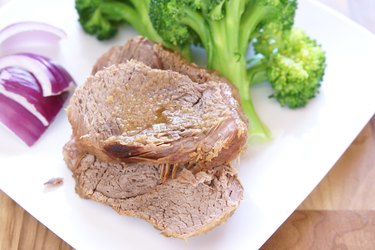
Cooked low and slow in the oven, beef shoulder becomes a savory dish that will wow your guests. This cut is inexpensive and versatile, offering both flavor and nutrition. Although it can be a bit tough, it becomes tender when prepared the right way.
Tip
The best way to cook tough cuts of meat, such as beef shoulder, is to braise them. Brown the meat in a skillet and then transfer it to the oven and cook it at a low temperature for a couple of hours or until its internal temperature reaches at least 145 degrees Fahrenheit.
Video of the Day
What Is a Shoulder Roast?
As its name suggests, this chuck cut comes from the shoulder area of a cow. It has a rich, beefy flavor and tastes best when roasted in the oven, according to the Cattlemen's Beef Board and National Cattlemen's Beef Association. Also known as a shoulder clod roast, pot roast or arm roast, it's leaner than the chuck roast and has only 200 calories per serving (3.3 ounces).
Video of the Day
When it comes to chuck cuts, low and slow is your best bet. The meat can be tough and has a lot of connective tissue, so it should be cooked at low temperatures for a couple of hours. You can roast it, braise it or throw it in a slow cooker before leaving home so you can enjoy a delicious meal later in the day.
The shoulder roast is just as healthy as it is delicious. Each serving boasts 17 grams of lean protein, 13 grams of fat and small amounts of iron. Cooking increases protein digestibility, reports a February 2016 review in the Scientific World Journal. Red meat, including beef shoulder, contains high-quality protein, which may help reduce body fat mass and prevent weight gain in adults.
Furthermore, beef contains branched-chain amino acids that may benefit athletes and active individuals, according to the above review. These nutrients regulate protein synthesis, support immune function and promote metabolic health, as noted in a July 2014 research paper featured in Advances in Molecular Biology.
Iron, another key nutrient in beef, is an integral component of several proteins and enzymes, including hemoglobin, an oxygen-carrying protein. Low levels of this mineral may lead to anemia, warns the U.S. National Library of Medicine. Your body needs iron to make red blood cells and hormones.
How to Braise Beef Shoulder
Cooking a beef roast in the oven takes some preparation and know-how. One option is trussing the meat before you roast it. This helps ensure even cooking, makes the roast easier to slice and enhances its visual appeal. On top of that, it keeps the meat from falling apart. The easiest way to tie a roast is to wrap a long piece of twine around the meat or make individual loops and then tie with a slipknot.
Dry the beef shoulder with paper towels after trussing it. Sprinkle salt over it and let it stand at room temperature for 60 minutes or longer. Browning the meat before roasting it is the key to a well-caramelized crust. Sear it in a pan or skillet and then put it in the oven.
There are two ways to cook a beef roast in the oven, according to best-selling cookbook author Jamie Geller. You can either braise it in liquid at low heat or roast it dry at high heat. The first option works best for tougher cuts, such as the beef shoulder roast, while the latter is ideal for tender cuts.
Read more: How to Cook a Chuck Roast Perfectly
Sear the meat in a hot frying pan or a Dutch oven at 425 F for five to eight minutes. Transfer it to a deep roasting pan. Add herbs and spices along with water, wine, beer or broth. Make sure the liquid covers two to three inches of the roast.
Cover with a lid or aluminum foil and cook at 250 F until the roast is tender. To stay on the safe side, use a food thermometer and wait until the meat reaches a minimum internal temperature of 145 F, as recommended by the USDA Food Safety and Inspection Service.
Let it rest for about 15 minutes to keep the juices intact and then cut into thin slices (against the grain) with a carving fork, a carving knife or an electric knife. If you're planning to eat everything at once, cut only the number of slices you need for a meal. Serve it with light side dishes, like our delicious Asian-Style Coleslaw or this refreshing LIVESTRONG.com Citrus Greens Salad, which has slightly more than 100 calories per serving.
- Cattlemen's Beef Board and National Cattlemen's Beef Association: "Shoulder Roast"
- USDA: "Nutrition Facts for Angus Beef Shoulder Roast"
- Scientific World Journal: "A Contribution of Beef to Human Health: A Review of the Role of the Animal Production Systems"
- Advances in Molecular Biology: "Metabolic and Physiological Roles of Branched-Chain Amino Acids"
- U.S. National Library of Medicine: "Iron"
- National Institutes of Health Office of Dietary Supplements: "Iron"
- Jamie Geller: "How Do I Cook a Roast?"
- USDA Food Safety and Inspection Service: "Safe Minimum Internal Temperature Chart"